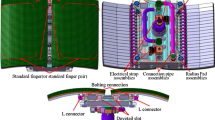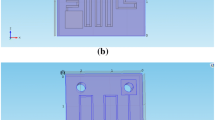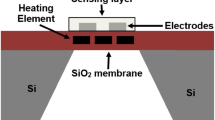Abstract
A micro heater with low temperature coefficient of resistance (TCR) at liquid hydrogen temperature was designed and fabricated by micro fabrication technology. The NiCr heater annealed in N2 at 250 °C for 9 min achieves a smallest TCR of 9.36 ppm/K at 20 K. The crystal structures of NiCr film annealed in nitrogen were analyzed by scanning electron microscope (SEM) and X-ray diffraction (XRD). The crystallization of NiCr film improved with the annealing temperature increasing. The fabricated micro heater applied in the temperature control test achieves the accuracy of ±0.5 mK, which is qualified for the temperature control accuracy requirement of the ignition target of inertial confinement fusion (ICF).
Similar content being viewed by others
Keywords
1 Introduction
As the energy problems become more urgent, fusion and solar-energy technology, as sub-critical clear energy, are solutions to the energy problem, and many researches are committed to this field. In the ICF experiment, ignition target as an essential part to induce a fusion reaction is supported at the ends of the cooling arms, as shown in Fig. 1. The support cooling arm grips the hohlraum to maintain the temperature for heat conduction. In the fusion experiment, the capsule must be precisely kept in liquid hydrogen temperature, and the temperature control accuracy must be less than 0.5 mK. In order to precisely control the temperature of cooling arm, a micro heater and a temperature sensor are employed on the cooling arm [1,2,3]. The temperature is controlled by adjusting the input power of the heater according to the difference of reference temperate and the measured value by the temperature sensor. The resistance variation of the micro heater affects the temperature control accuracy. So, the micro heater applied in the fusion ignition target should have a nearly zero temperature coefficient of resistance (TCR).
The model of fusion energy ignition target (exploded) [2]
NiCr alloy is normally used as the material of the micro heater due to its low TCR, good stability and adhesion force with many kinds of substrates, such as silicon, Sapphire, and polymers [4]. Many research have found that the film deposition condition and post deposition treatment can influence the NiCr thin films on its crystalline [5,6,7,8,9,10,11,12,13]. Nguyen et al. [6] investigated the chromium concentration has relationship with the crystalline nature of the NiCr films. The resistance of NiCr alloys increases and the TCR decreases along with the chromium concentration increasing. And the films would change from crystalline to amorphous phase when the chromium concentration increase to 40% or above. As the deposited NiCr films with chromium concentration above 40% have a negative TCR and annealing treating can increase the TCR of the film into a positive value. Therefore, a micro heater with nearly zero TCR is possible by annealing at a certain temperature in nitrogen ambient. Iida and Nakamura [7] found that the NiCr film with a Ti layer underneath could improve the crystalline. And Nachrodt et al. [8] acquired a NiCr film with a TCR below 10 ppm/K by adding an exact 5 nm Ti layer and an optimized annealing condition. However, the thickness of the Ti layer is hard to control in nanometer level by normal sputtering. Most of the literatures study the TCR under ambient temperature (about 300 K), but the micro heater for fusion energy application works at the temperature around liquid hydrogen temperature. So, this paper put emphasis on the investigation of the TCR at cryogenic temperature (around 20 K).
2 The Design of Micro Heater
Micro heater in fusion energy application is mounted on the cooling arm. During the heating process, the Joule heat of the NiCr film transfers though the substrate to the cooling arm by conduction mechanism. In order to improve the heat-transfer efficiency, the substrate should have high thermal conductivity at cryogenic temperature. Silicon as the most commonly used semiconductor material with high thermal conductivity of 2400 W/m.K at liquid hydrogen temperature is selected as the substrate of micro heater.
The NiCr thin film (60/40 at. %) is deposited on SiO2/Si. There are five different patterns of NiCr film designed in this paper, which are shown in Fig. 2. As the heater is mounted on the cooling arm to conduct heat, the temperature on the bottom surface should distribute as uniformly as possible, so that the temperature control of the cooling arm can be more precise. In order to calculate the temperature distribution of the micro heater, the simulation software COMSOL was applied, and the temperature distributions on the bottom surface of the heaters with different patterns are illustrated in Fig. 3. As can be seen from the legend of each simulation, the temperature range of the heater with pattern (c) is the smallest, so the pattern (c) of the NiCr film is established as the final design.
3 Fabrication Process of Cooling Arm
The micro heater is fabricated by micro fabrication technology. The fabrication process is described in Fig. 4. In step (1), the oxide silicon wafer is ultrasonic cleaned by acetone, isopropanol and deionized water separately. In step (2), approximately 200 nm-thickness NiCr film is deposited on the silicon wafer by magnetron sputtering from a 60%Ni-40%Cr target. In step (3), 5 μm photoresist (AZ4620) is spin-coated on the NiCr thin film. In step (4), the photo resist is exposed and developed. In step (5), the NiCr thin film is etched by plasma etching method for 20 min. In step (6), the photo resist is removed by acetone, isopropanol and deionized water. In step (7), 10 μm photo resist (AZ4620) is spin-coated on the pattern surface. In step (8), the photo resist is exposed and developed. In step(9), 200 nm Cr/Au electrode is deposited on the wafer. In step (10), the photo resist was lifted off from the surface of the NiCr thin film in acetone. The fabricated micro heater is shown in Fig. 5.
4 Film Annealing and TCR Measurement
In order to reduce the TCR of the fabricated heater, an annealing device RTP500 (Rapid Thermal Processor) is used to perform the annealing process at 250 °C, 350 °C, 450 °C, 600 °C for 9 min respectively. As Cr is easily oxidized, the heaters are annealed in nitrogen ambient. The TCR of the heaters are calculated by formula (1).
Where Rt and R0 are the resistance of thin-film heaters at the temperature of t and 300 K respectively. In order to figure out the optimal annealing temperature for the smallest TCR of the micro heater, the Physical Property Measurement System (PPMS) equipment, as shown in Fig. 6(a), is used to measure the resistances of the samples at the temperature range from 10 K to 300 K,and the micro heaters are fixed on a sample test holder during the measurement, as shown in Fig. 6(b).
As can been seen from the R-T curve of the testing samples in the Fig. 7, the as-deposited heater has a negative TCR as the resistance decreasing along with the temperature increasing, and the TCR becomes positive after annealing. Also, the resistance of the heaters decreases as the annealing temperature increase. The TCR of each sample at 20 K is calculated by formula (1) and listed in Table 1. The sample annealed at 250 °C has the lowest TCR at 20 K, which is 9.36 ppm/K.
5 Discussion
The resistance of most metal is generally due to the electron scattering caused by the thermal vibrations of the atoms. As the scattering probability increases with temperature increasing, the resistance of metal will increase correspondingly. As for the amorphous alloys, the electrical transport properties research is still at the stage of establishing theoretical model. Following the theory of Mooij and Tsuei, the amorphous alloys could exhibit a negative TCR. On the basis of the literature [11], it is known that the sputtered NiCr film with chromium concentration of 40% exhibits an amorphous nature, so the TCR of as-deposited NiCr film is negative. Along with the annealing temperature increase, the crystallization of NiCr film will improve, and the TCR value will become positive or even higher.
In order to verify the above theoretical analysis, the crystal structures of NiCr film annealed in nitrogen were analyzed by scanning electron microscope (SEM) and X-ray diffraction (XRD). Figure 8 shows the film surface morphology of the NiCr films. The surface morphology of films annealed under 350 °C are smooth, and the crystal grains can hardly be found, because the film still exhibits amorphous nature. When the annealing temperature increased to 450 °C, the crystals grown above 20 nm is observed. When the annealing temperature is 600 °C, the formed crystals combined each other and became larger, as shown in Fig. 8(d). The XRD of NiCr films are shown in Fig. 9, and the Ni(Cr) diffraction peak can be found. According to the NiCr alloy phase diagram [14], NiCr film constitutes only γ-Ni terminal solid solution with face-centered cubic (fcc) structure. As can be seen from Fig. 9, γ-Ni(Cr)(111) has a wide diffraction peak, so the as-deposited NiCr film has not completely crystallization. With the increasing of the annealing temperature, the diffraction peak intensity increases. It proves that the crystallization of NiCr film improves with the annealing temperature increasing.
6 Performance Test of Micro Heater
6.1 Response Time Measurement
In order to test the performance of the micro heater, a experiment system, which is illustrated in Fig. 10, is built to measure and calculate the response time of the micro heater. The clamping apparatus is design to bind the micro heater and the thermocouple measuring end. The micro heater and the thermocouple measuring end are attached to the cushions separately. By adjusting the nuts in the clamping apparatus, the micro heater will contact well with the thermocouple measuring end on its bottom face. The compensating end of the thermocouple is placed in the ice point cell where the temperature is constant at zero degree Celsius. The universal analog input module (NI 9219, National Instruments) is used to transfer the voltage data of the thermocouple into data on temperature, and input the data to the PC. While a constant voltage of 6 V is inputted to the micro heater by the DC power supply, the temperature will rise from room temperature to steady-state temperature, and the PC will store all the temperature data of NI 9219 collected from the thermocouple. As can be seen from the temperature-rise period of the micro heater which is illustrated in Fig. 11, the temperature rises from 292.87 K to 346.42 K. Normally, 63.2% of the temperature incensement is defined as the respond time of the micro heater. Thus, the response time of the fabricated heater is 11.3 s, which has a quick response own to the chosen substrate material silicon has a large coefficient of thermal conductivity.
6.2 Temperature Control Accuracy Test
The assembly of the cooling arm is shown in Fig. 12. The micro heater and a micro temperature sensor are mounted on the cooling arm by epoxy (Sytcast Epoxy 2850-FT), and connect to the golden lead by wire bonding respectively. The setup test system for evaluate the performance of the micro heater is shown in Fig. 13. A GM cryocooler (Sumitomo SRDK408) is used as the cold source, whose second stage cold head can provide 1 W and 13 W cooling power at 4.2 K and 18 K, respectively. The cooling arm assembly was fixed to the cooling head of the GM cooler. And a temperature controller (Cryocon 24C) is used to monitor the temperature of the temperature sensor and automatically adjust the power loaded on the heater by PID control method.
In the temperature control experiment, the temperature of cooling arm is controlled in PID mode. Before the temperature controller works, the temperature of the cooling arm is cooled down to 18.18 K. As can be seen from Fig. 14(a), the temperature reaches the steady state in 220 s by the temperature controller adjusting the power of the micro heater. As shown in Fig. 14(b), the temperature fluctuation of the cooling arm in steady state is ±0.5 mK, which meets the accuracy requirement of the temperature control.
7 Conclusions
A cryogenic thin-film heater made of NiCr alloy was design and fabricated. Through the finite element analysis of the temperature distribution, the NiCr film pattern is optimize designed. In order to obtain a small TCR at liquid hydrogen temperatures, the films were treated under various annealing treatments. According to the TCR measurement at the temperature range from10 K to 300 K, the heater annealing in N2 at 250 °C has the smallest TCR of 9.36 ppm/K at 20 K. Through the response measurement and the temperature control experiments at liquid hydrogen temperature, the fabricated heater has a quick response and meets the requirements of temperature control accuracy.
References
Miles, R., Hamilton, J., Crawford, J., Ratti, S., Trevino, J., Graff, T., Stockton, C., Harvey, C.: Microfabricated deep-etched structures for ICF and equation-of-state targets. Fusion Sci. Technol. 55(3), 308–312 (2009)
Miles, R., et al.: Micro-fabrication techniques for target components. Fusion Sci. Technol. 55(3), 308–312 (2009)
Khater, H., Brereton, S.: Radiological assessment of target debris in the National Ignition Facility. In: 23rd IEEE/NPSS Symposium, Fusion Engineering, SOFE, pp. 1–4 (2009)
Kazi, I.H., Wild, P.M., Moore, T.N., Sayer, M.: Characterization of sputtered nichrome (Ni–Cr 80/20 wt.%) films for strain gauge applications. Thin Solid Films 515(4), 2602–2606 (2006)
Kim, H.S., Kim, B.O., Seo, J.H.: A study on the adhesion properties of reactive sputtered molybdenum thin films with nitrogen gas on polyimide substrate as a Cu barrier layer. J. Nanosci. Nanotechnol. 15, 8743–8748 (2015)
Phuong, N.M., Kim, D.-J., Kang, B.-D., Yoon, S.-G.: Structural and electrical properties of NiCr thin films annealed at various temperatures in a vacuum and a nitrogen ambient for π-type attenuator applications. J. Electrochem. Soc. 153(7), 660–663 (2006)
Iida, A., Nakamura, S.-I.: Orientation of Ni-Cr thin films with an underlying Ti layer. Jpn. J. Appl. Phys. 35(3A), 335–337 (1996)
Nachrodt, D., Paschen, U., Ten Have, A., Vogt, H.: Ti/Ni (80%)Cr (20%) Thin-film resistor with a nearly zero temperature coefficient of resistance for integration in a standard CMOS process. IEEE Electron Device Lett. 29(3), 212–214 (2008)
Belič, L.I., Požun, K., Remškar, M.: AES, AFM and TEM studies of NiCr thin films for capacitive humidity sensors. Thin Solid Films 317(1–2), 173–177 (1998)
Au, C.L., Jackson, M.A., Anderson, W.A.: Structural and electrical properties of stable Ni/Cr thin films. J. Electron. Mater. 16(4), 301–306 (1987)
Phuong, N.M., Kim, D.-J., Kang, B.-D., Kim, C.S., Yoon, S.-G.: Effect of chromium concentration on the electrical properties of NiCr thin films resistor deposited at room temperature by magnetron cosputtering technique. J. Electrochem. Soc. 153(1), 27–29 (2006)
Lai, L., Zeng, W., Fu, X., Sun, R., Du, R.: Anneling effect on the electrical properties and microstructure of embedded Ni-Cr thin film resistor. J. Alloys Compd. 538, 125–130 (2012)
Kwon, Y., Kim, N.-H., Choi, G.-P., Lee, W.-S., Seo, Y.-J., Park, J.: Structural and surface properties of NiCr thin films prepared by DC magnetron sputtering under variation of annealing conditions. Microelectron. Eng. 82(3–4), 314–320 (2005)
Rolke, J.: Nichrome thin film technology and its application. Electrocompon. Sci. Technol. 9(1), 51–57 (1981)
Acknowledgments
This work was supported in part by the National Natural Science Foundation of China (51565038), the department of education of Jiangxi province (GJJ170987, GJJ180936).
Author information
Authors and Affiliations
Corresponding author
Editor information
Editors and Affiliations
Rights and permissions
Copyright information
© 2019 Springer Nature Switzerland AG
About this paper
Cite this paper
Xu, B., Li, Z., Tang, G., Bao, Y., Wang, H. (2019). Micro Heater with Low Temperature Coefficient of Resistance for ICF Target. In: Milošević, D., Tang, Y., Zu, Q. (eds) Human Centered Computing. HCC 2019. Lecture Notes in Computer Science(), vol 11956. Springer, Cham. https://doi.org/10.1007/978-3-030-37429-7_49
Download citation
DOI: https://doi.org/10.1007/978-3-030-37429-7_49
Published:
Publisher Name: Springer, Cham
Print ISBN: 978-3-030-37428-0
Online ISBN: 978-3-030-37429-7
eBook Packages: Computer ScienceComputer Science (R0)


















